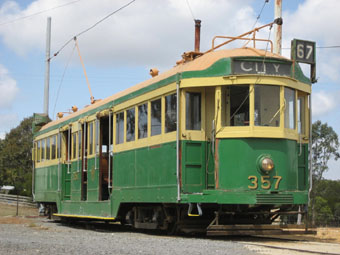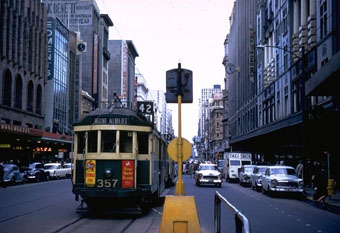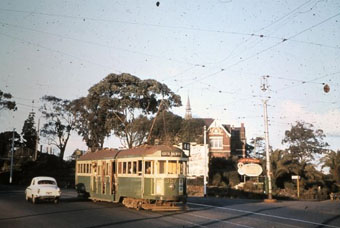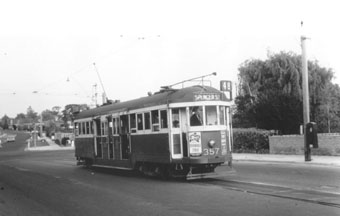W Class 357

357 awaits departure from the Upper Terminus at Haddon.
Photo courtesy Mal Rowe

357 proceeds along Bourke Street towards Swanston Street. This section of Bourke Street is now the Bourke Street Mall.
Photo – Anthony Smith collection

357 heads towards North Balwyn terminus along Doncaster Road.
Photo – Unknown photographer, from TMSV slide

Peter Bruce captioned this photo ‘An Honest Face’ – reflecting the simple and clean lines of a W Class front without the later addition of multiple head and tail lights, in this view of 357 in the Carbarn at Haddon.
Photo courtesy Peter Bruce

357 at North Balwyn terminus, awaiting departure to Spencer Street.
Photo – MTPA Collection
W Class 357 entered service on the 30 January 1926, being built by the MMTB. It is of significance as it is the last tram to be entirely constructed at the Holden St Tramway Workshops. Subsequent trams built by the Tramways Board were constructed in their entirety at Preston Workshops.
The W Class were the first trams to be ordered by the MMTB after its formation, and were designed as a standard class of trams to replace some of the smaller batches of trams previously operated by the many tramway trusts and companies in Melbourne. 200 trams of this design were constructed by four builders between 1923 and 1926.
An adaptation of the W Class that had a dropcentre section reminiscent of the seating layout of the cable tram dummy’s became known as the W1 Class, and another version featuring an improved semi-enclosed dropcentre section was classified as the W2 Class. The W2 Class design soon became the standard design, with 180 trams built to this design, and the 200 W Class and 26 W1 Class converted to the W2 Class design between 1928 and 1937.
357 was converted to a W2 class tram in the early 1930’s and operated in this form for nearly forty years until it was withdrawn and stored at Hawthorn Depot on the 18 November 1968.
The Association purchased 357 after viewing it in storage, and it was delivered to the museum on the 18 April 1977 after having run a total of 2,160,827 Miles in Melbourne.
The intention is to restore 357 back to its original W class configuration and chocolate brown and cream livery to represent the genesis of the W class tram era. 357 is currently stored operational in its W2 Class configuration.
The following are W 357’s current technical details and specifications:
Builder – MMTB’s Holden St Tramway Workshops
Entered Service – 30 January 1926
Length – 14.59 metres (47ft, 10 ½in)
Height – 3.19 metres (10ft, 5 7/8in)
Width – 2.74 metres (9ft, 0in)
Weight – 17.95 tonnes (17.6 tons)
Seated Passengers – 52
Trucks – MMTB No. 1B, 26 ½” tyred wheels
Traction Motors – 4 x 30 kW (40HP) Metropolitan Vickers MV101A/AN
Controllers – General Electric K35JJ
Line Breaker – General Electric Type D.B. 276
Brake Valves – Westinghouse Type “W” Self Lapping
Air Compressor – General Electric Type CP27
Compressor Governor – General Electric Type ML
Braking System – Compressed air and hand applied
Maximum Acceleration – 2.5 M.P.H. per second
Maximum Design Gradient – 8.5 %
Lighting Circuits – 3 circuits each with 6 x 100 volt series lamps
Trolley Bases – US15